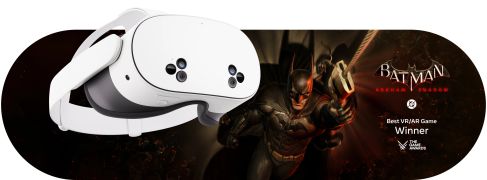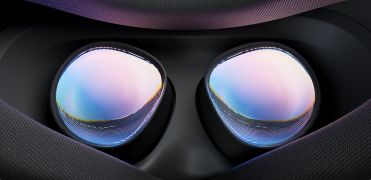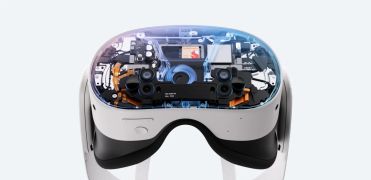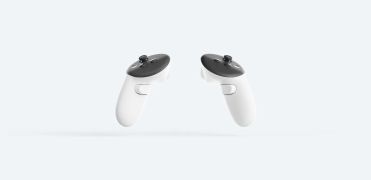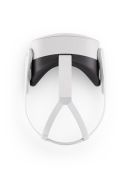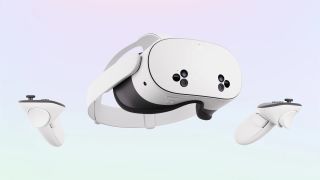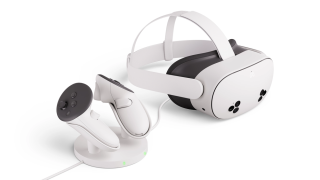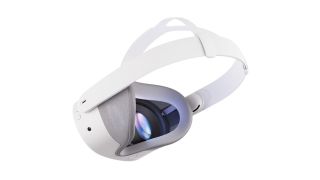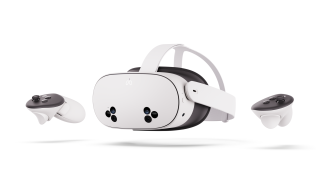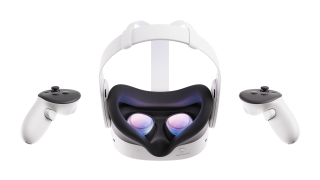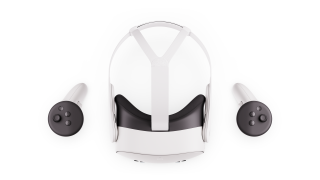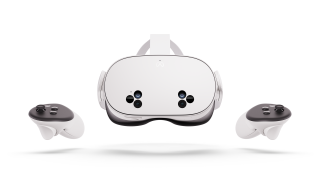Meta Quest 3S: Difference between revisions
Xinreality (talk | contribs) Created page with "{{Device Infobox |image = |VR/AR = Virtual Reality |Type = Head-mounted display |Subtype = Standalone VR headset |Platform = Meta Quest |Creator = |Developer = Meta |Manufacturer = Meta |Announcement Date = September 25, 2024 |Release Date = October 15, 2024 |Price = $299 (128GB), $399 (256GB) |Website = https://www.meta.com/quest/quest-3s/ |Versions = 128GB, 256GB |Requires = Meta account |Predecessor = Meta Quest 2 |Succe..." |
RealEditor (talk | contribs) Re |
||
| (11 intermediate revisions by one other user not shown) | |||
| Line 1: | Line 1: | ||
{{Device Infobox | {{Device Infobox | ||
|image = | |image = [[File:meta quest s320.png|350px]] | ||
|VR/AR = Virtual Reality | |VR/AR = [[Virtual Reality]] | ||
|Type = Head-mounted display | |Type = [[Head-mounted display]] | ||
|Subtype = Standalone VR | |Subtype = [[Standalone VR]] | ||
|Platform = [[Meta Quest]] | |Platform = [[Meta Quest]] | ||
|Creator = | |Creator = [[Meta]] | ||
|Developer = [[ | |Developer = [[Meta]] | ||
|Manufacturer = [[ | |Manufacturer = [[Meta]] | ||
|Announcement Date = September 25, 2024 | |Announcement Date = September 25, 2024 | ||
|Release Date = October 15, 2024 | |Release Date = October 15, 2024 | ||
| Line 33: | Line 33: | ||
|Precision = | |Precision = | ||
|Field of View = | |Field of View = | ||
|Horizontal FoV = 96 degrees | |Horizontal FoV = ~96 degrees | ||
|Vertical FoV = 90 degrees | |Vertical FoV = ~90 degrees | ||
|Visible FoV = | |Visible FoV = | ||
|Rendered FoV = 104° horizontal, 98° vertical | |Rendered FoV = 104° horizontal, 98° vertical | ||
| Line 46: | Line 46: | ||
|Adjustable Diopter = No | |Adjustable Diopter = No | ||
|Passthrough = Color, 18 PPD | |Passthrough = Color, 18 PPD | ||
|Tracking = 6DoF inside-out | |Tracking = 6DoF, [[inside-out tracking]] | ||
|Tracking Frequency = | |Tracking Frequency = | ||
|Base Stations = None | |Base Stations = None | ||
| Line 72: | Line 72: | ||
|Battery Capacity = 4324 mAh | |Battery Capacity = 4324 mAh | ||
|Battery Life = ~2.5 hours | |Battery Life = ~2.5 hours | ||
|Charge Time = | |Charge Time = ~1.8 hours (110 minutes) | ||
|Dimensions = 191.5 x 102 x 142.5 mm (without headstrap) | |Dimensions = 191.5 x 102 x 142.5 mm (without headstrap) | ||
|Weight = 514g (with headstrap) | |Weight = 514g (with headstrap) | ||
| Line 80: | Line 80: | ||
|Color = White | |Color = White | ||
|Sensors = 2x RGB sensors, 4x VGA sensors, 2x IR Flood LEDs | |Sensors = 2x RGB sensors, 4x VGA sensors, 2x IR Flood LEDs | ||
|Input = Touch Plus controllers, hand tracking | |Input = [[Touch Plus controllers]], [[hand tracking]] | ||
|Compliance = | |Compliance = | ||
|Size = | |Size = | ||
|Cable Length = | |Cable Length = | ||
}} | }} | ||
[[Meta Quest 3S]] is a [[standalone]] [[virtual reality headset]] developed by [[Meta]]. Released on October 15, 2024<ref name="uploadvr1" />, it was announced during [[Meta Connect 2024]] on September 25, 2024<ref name="uploadvr1" />. The Quest 3S is Meta's entry-level VR headset, positioned as a more affordable alternative to the [[Meta Quest 3]] with some scaled-back features while maintaining the same processing power<ref name="roadtoVR" /><ref name="uploadvr1" />. | |||
== History and Development == | == History and Development == | ||
The Meta Quest 3S was officially announced by Meta on September 25, 2024, during the Meta Connect 2024 event, with preorders opening the same day. It began shipping on October 15, 2024. The headset was developed to replace the aging Meta Quest 2 as the company's affordable entry point into VR and MR, sitting below the flagship Meta Quest 3 in the product lineup. This marked a shift for Meta, offering two distinct tiers within the same generation of Quest headsets. The existence and name of the device were leaked prior to the official announcement. | The Meta Quest 3S was officially announced by Meta on September 25, 2024, during the Meta Connect 2024 [[event]], with preorders opening the same day<ref name="uploadvr1" />. It began shipping on October 15, 2024<ref name="uploadvr1" />. The headset was developed to replace the aging [[Meta Quest 2]] as the company's affordable entry point into VR and MR, sitting below the flagship Meta Quest 3 in the product lineup<ref name="guardian" /><ref name="verge">{{cite web |url=https://www.theverge.com/24340948/meta-quest-3s-vr-headset-review |title=Meta Quest 3S review: probably the one we've been waiting for |last=Peters |first=Jay |date=January 14, 2025 |website=The Verge |accessdate=May 4, 2025}}</ref>. This marked a shift for Meta, offering two distinct tiers within the same generation of Quest headsets<ref name="wired">{{cite web |url=https://www.wired.com/review/meta-quest-3s/ |title=Review: Meta Quest 3S |last=Unknown |first= |date=November 2, 2024 |website=Wired |accessdate=May 4, 2025}}</ref>. The existence and name of the device were leaked prior to the official announcement<ref name="vr-compare" />. | ||
== Hardware == | == Hardware == | ||
=== Design and Ergonomics === | === Design and Ergonomics === | ||
The Quest 3S features a white plastic body similar in overall shape to the Quest 2, but with redesigned sensor arrays on the front panel, featuring two triangular clusters instead of the Quest 3's vertical pill shapes. Although physically similar in weight to the Quest 3 at 514 grams (including the default strap), its use of bulkier Fresnel lenses means the center of gravity is further from the face, which some reviewers found slightly less comfortable or secure compared to the Quest 3. | The Quest 3S features a white plastic body similar in overall shape to the Quest 2<ref name="pcmag" /><ref name="guardian" />, but with redesigned sensor arrays on the front panel, featuring two triangular clusters instead of the Quest 3's vertical pill shapes<ref name="pcmag" />. Although physically similar in weight to the Quest 3 at 514 grams (including the default strap)<ref name="uploadvr1" /><ref name="pcmag" />, its use of bulkier Fresnel lenses means the center of gravity is further from the face, which some reviewers found slightly less comfortable or secure compared to the Quest 3<ref name="techradar">{{cite web |url=https://www.techradar.com/computing/virtual-reality-augmented-reality/meta-quest-3s-review-an-affordable-mixed-reality-headset-that-everyone-might-want |title=Meta Quest 3S review: the world's best affordable VR headset |last=Hector |first=Hamish |date=October 14, 2024 |website=TechRadar |accessdate=May 4, 2025}}</ref><ref name="pcgamer" />. | ||
It ships with a basic fabric Y-style headstrap, similar to the one included with the Quest 2 and Quest 3, which many reviewers found lacked adequate support or counterweight for the front-heavy design, often recommending an upgrade to an [[Elite Strap]] style accessory. Notably, the Quest 3S strap attachment points are compatible with most existing Quest 3 headstraps. A new physical "Action Button" is located on the underside of the headset, allowing users to quickly toggle between immersive VR and the passthrough view, replacing the double-tap gesture used on Quest 3 (though the double-tap gesture may still function). Unlike the Quest 2 and Quest 3, the Quest 3S lacks an internal [[proximity sensor]], meaning the display doesn't automatically turn on or off when the headset is put on or removed; users must press the power button. | It ships with a basic fabric Y-style headstrap, similar to the one included with the Quest 2 and Quest 3<ref name="roadtoVR" />, which many reviewers found lacked adequate support or counterweight for the front-heavy design, often recommending an upgrade to an [[Elite Strap]] style accessory<ref name="roadtoVR" /><ref name="guardian" /><ref name="mixed-news">{{cite web |url=https://mixed-news.com/en/meta-quest-3s-review/ |title=Meta Quest 3S Review: An entry-level VR headset that doesn't always make things easy for beginners |last=Erl |first=Josef |date=December 15, 2024 |website=MIXED Reality News |accessdate=May 4, 2025}}</ref>. Notably, the Quest 3S strap attachment points are compatible with most existing Quest 3 headstraps<ref name="uploadvr1" /><ref name="roadtoVR" /><ref name="ign">{{cite web |url=https://www.ign.com/articles/meta-quest-3s-review |title=Meta Quest 3S Review |last=Moss |first=Gabriel |date=October 24, 2024 |website=IGN |accessdate=May 4, 2025}}</ref>. A new physical "Action Button" is located on the underside of the headset, allowing users to quickly toggle between immersive VR and the passthrough view<ref name="uploadvr1" /><ref name="guardian" />, replacing the double-tap gesture used on Quest 3<ref name="tomsguide">{{cite web |url=https://www.tomsguide.com/computing/vr-ar/meta-quest-3s-review |title=Meta Quest 3S review: The best VR headset for the money |last=Polanco |first=Tony |date=October 14, 2024 |website=Tom's Guide |accessdate=May 4, 2025}}</ref> (though the double-tap gesture may still function). Unlike the Quest 2 and Quest 3, the Quest 3S lacks an internal [[proximity sensor]], meaning the display doesn't automatically turn on or off when the headset is put on or removed; users must press the power button<ref name="roadtoVR" />. | ||
=== Display and Optics === | === Display and Optics === | ||
The most significant cost-saving measure and point of differentiation from the Quest 3 lies in the Quest 3S's display and optical system, which is largely repurposed from the Meta Quest 2. It uses a single fast-switch [[LCD]] panel providing a resolution of 1832 x 1920 pixels per eye, identical to the Quest 2. This results in a lower pixel density (approximately 20 [[Pixels Per Degree]] or PPD) compared to the Quest 3's 25 PPD (2064 x 2208 per eye). While the resolution difference wasn't always drastically noticeable in games due to rendering limitations, reviewers consistently noted that the Quest 3 offered a significantly sharper and clearer image, especially for text or fine details. | The most significant cost-saving measure and point of differentiation from the Quest 3 lies in the Quest 3S's display and optical system, which is largely repurposed from the Meta Quest 2<ref name="pcmag" /><ref name="techradar" />. It uses a single fast-switch [[LCD]] panel providing a resolution of 1832 x 1920 pixels per eye, identical to the Quest 2<ref name="pcmag" /><ref name="vr-compare" />. This results in a lower pixel density (approximately 20 [[Pixels Per Degree]] or PPD)<ref name="uploadvr1" /> compared to the Quest 3's 25 PPD (2064 x 2208 per eye)<ref name="pcmag" />. While the resolution difference wasn't always drastically noticeable in games due to rendering limitations, reviewers consistently noted that the Quest 3 offered a significantly sharper and clearer image, especially for text or fine details<ref name="pcmag" /><ref name="techradar" /><ref name="mixed-news" />. | ||
The Quest 3S employs [[Fresnel lenses]], also inherited from the Quest 2. These lenses are known for having a smaller "sweet spot" (the central area of maximum clarity) compared to the [[pancake lenses]] used in the Quest 3. Image sharpness noticeably decreases towards the edges of the field of view, and Fresnel lenses are more prone to [[glare]] and god rays (internal reflections) in high-contrast scenes. The [[field of view]] (FoV) is also narrower than the Quest 3, measured at approximately 96-97° horizontal and 90-93° vertical, compared to the Quest 3's 110° horizontal and 96° vertical. | The Quest 3S employs [[Fresnel lenses]], also inherited from the Quest 2<ref name="uploadvr1" /><ref name="pcmag" />. These lenses are known for having a smaller "sweet spot" (the central area of maximum clarity) compared to the [[pancake lenses]] used in the Quest 3<ref name="roadtoVR" /><ref name="techradar" />. Image sharpness noticeably decreases towards the edges of the field of view<ref name="roadtoVR" /><ref name="mixed-news" />, and Fresnel lenses are more prone to [[glare]] and god rays (internal reflections) in high-contrast scenes<ref name="roadtoVR" /><ref name="mixed-news" />. The [[field of view]] (FoV) is also narrower than the Quest 3, measured at approximately 96-97° horizontal and 90-93° vertical<ref name="pcmag" /><ref name="vr-compare" />, compared to the Quest 3's 110° horizontal and 96° vertical<ref name="pcmag" />. | ||
[[Interpupillary distance]] (IPD) adjustment is limited to three fixed hardware positions: 58mm, 63mm, and 68mm, similar to the Quest 2. Users manually shift the lenses between these preset grooves. This contrasts with the Quest 3's continuous IPD adjustment wheel (53-75mm range), potentially making it harder for some Quest 3S users to achieve optimal visual clarity and comfort if their IPD falls between the presets. The headset includes a glasses spacer, and is compatible with Quest 2 prescription lens inserts. | [[Interpupillary distance]] (IPD) adjustment is limited to three fixed hardware positions: 58mm, 63mm, and 68mm, similar to the Quest 2<ref name="uploadvr1" /><ref name="pcmag" />. Users manually shift the lenses between these preset grooves<ref name="techradar" />. This contrasts with the Quest 3's continuous IPD adjustment wheel (53-75mm range)<ref name="pcmag" />, potentially making it harder for some Quest 3S users to achieve optimal visual clarity and comfort if their IPD falls between the presets<ref name="techradar" /><ref name="mixed-news" />. The headset includes a glasses spacer<ref name="uploadvr1" />, and is compatible with Quest 2 prescription lens inserts<ref name="uploadvr1" />. | ||
=== Processor and Performance === | === Processor and Performance === | ||
The Quest 3S is powered by the [[Qualcomm]] [[Snapdragon XR2 Gen 2]] system-on-chip, paired with 8GB of [[RAM]]. This is the same processor and memory configuration found in the more expensive Quest 3, representing a significant performance upgrade over the Quest 2's Snapdragon XR2 Gen 1 processor (Meta claims roughly double the GPU performance). This allows the Quest 3S to run all existing Quest Store games and apps, including titles designed with enhanced graphics for the Quest 3 platform, such as ''[[Batman: Arkham Shadow]]'' (which was bundled free with the headset for a promotional period). Reviewers noted that the headset felt responsive and smooth in operation, with faster load times compared to the Quest 2. | The Quest 3S is powered by the [[Qualcomm]] [[Snapdragon XR2 Gen 2]] system-on-chip, paired with 8GB of [[RAM]]<ref name="uploadvr1" /><ref name="pcmag" />. This is the same processor and memory configuration found in the more expensive Quest 3, representing a significant performance upgrade over the Quest 2's Snapdragon XR2 Gen 1 processor (Meta claims roughly double the GPU performance)<ref name="guardian" /><ref name="meta" />. This allows the Quest 3S to run all existing Quest Store games and apps, including titles designed with enhanced graphics for the Quest 3 platform, such as ''[[Batman: Arkham Shadow]]'' (which was bundled free with the headset for a promotional period)<ref name="tomsguide" /><ref name="techradar" />. Reviewers noted that the headset felt responsive and smooth in operation, with faster load times compared to the Quest 2<ref name="guardian" /><ref name="tomsguide" />. | ||
=== Tracking and Controllers === | === Tracking and Controllers === | ||
The Quest 3S utilizes [[inside-out tracking]] with 6 [[degrees of freedom]] (DoF) via four integrated monochrome tracking cameras located on the front and sides of the headset. Meta's inside-out tracking is generally considered robust and class-leading for standalone headsets. The headset includes two [[Infrared]] (IR) flood illuminators, which improve hand tracking and controller tracking performance in low-light conditions, allowing tracking to function even in complete darkness in some scenarios – an area where it potentially outperforms the Quest 3. The Quest 3S lacks the dedicated [[depth sensor]] found on the Quest 3, which is used by the latter to improve the speed and accuracy of automatic room scanning (scene meshing) for mixed reality setup. | The Quest 3S utilizes [[inside-out tracking]] with 6 [[degrees of freedom]] (DoF) via four integrated monochrome tracking cameras located on the front and sides of the headset<ref name="vr-compare" />. Meta's inside-out tracking is generally considered robust and class-leading for standalone headsets<ref name="roadtoVR" />. The headset includes two [[Infrared]] (IR) flood illuminators, which improve hand tracking and controller tracking performance in low-light conditions, allowing tracking to function even in complete darkness in some scenarios – an area where it potentially outperforms the Quest 3<ref name="uploadvr2">{{cite web |url=https://www.uploadvr.com/quest3s-hand-tracking-better-than-quest-3/ |title=Quest 3S Has Better Low-Light Head & Hand Tracking Than Quest 3 |last=Heaney |first=David |date=October 10, 2024 |website=UploadVR |accessdate=May 4, 2025}}</ref><ref name="roadtoVR" />. The Quest 3S lacks the dedicated [[depth sensor]] found on the Quest 3, which is used by the latter to improve the speed and accuracy of automatic room scanning (scene meshing) for mixed reality setup<ref name="uploadvr1" />. | ||
The headset comes bundled with the same Meta Quest Touch Plus controllers used by the Quest 3. These controllers feature a more compact design without the tracking rings found on the Quest 2's controllers, incorporate [[haptics]] (branded as TruTouch Haptics), and use capacitive sensors on the buttons, thumbsticks, and triggers for basic finger presence detection. They are powered by standard AA batteries. While generally praised for their ergonomics and tracking accuracy, some tracking issues can occur if the controllers are held outside the headset cameras' view for extended periods ( | The headset comes bundled with the same Meta Quest Touch Plus controllers used by the Quest 3<ref name="uploadvr1" /><ref name="roadtoVR" />. These controllers feature a more compact design without the tracking rings found on the Quest 2's controllers<ref name="roadtoVR" />, incorporate [[haptics]] (branded as TruTouch Haptics)<ref name="uploadvr1" />, and use capacitive sensors on the buttons, thumbsticks, and triggers for basic finger presence detection<ref name="roadtoVR" />. They are powered by standard AA batteries<ref name="roadtoVR" /><ref name="guardian" />. While generally praised for their ergonomics and tracking accuracy<ref name="guardian" />, some tracking issues can occur if the controllers are held outside the headset cameras' view for extended periods (for example behind the back)<ref name="roadtoVR" />. Hand tracking is supported and benefits from the IR illuminators in low light<ref name="uploadvr2" />, though its accuracy and usability within the [[Horizon OS]] interface were still critiqued by some reviewers as occasionally frustrating<ref name="roadtoVR" /><ref name="mixed-news" />. | ||
=== Audio === | === Audio === | ||
Audio is delivered via integrated [[spatial audio]] speakers built into the headstrap arms, similar to the Quest 3. Reviewers generally found the audio quality to be good enough that external headphones aren't strictly necessary for most users. However, the Quest 3S notably omits the 3.5mm headphone jack found on the Quest 2 and Quest 3. Users wanting to use private audio must rely on [[USB-C]] headphones or [[Bluetooth]] wireless headphones. | Audio is delivered via integrated [[spatial audio]] speakers built into the headstrap arms, similar to the Quest 3<ref name="roadtoVR" /><ref name="guardian" />. Reviewers generally found the audio quality to be good enough that external headphones aren't strictly necessary for most users<ref name="roadtoVR" /><ref name="guardian" />. However, the Quest 3S notably omits the 3.5mm headphone jack found on the Quest 2 and Quest 3<ref name="uploadvr1" /><ref name="guardian" />. Users wanting to use private audio must rely on [[USB-C]] headphones or [[Bluetooth]] wireless headphones<ref name="uploadvr1" /><ref name="guardian" />. | ||
=== Passthrough and Mixed Reality === | === Passthrough and Mixed Reality === | ||
A key upgrade over the Quest 2 is the inclusion of full-color stereo [[passthrough]] cameras (dual RGB sensors), enabling [[mixed reality]] experiences where virtual elements are overlaid onto the user's real-world surroundings. Meta states the passthrough resolution is 4.5 times higher than the Quest 2's. While a significant improvement over the Quest 2's low-resolution black-and-white passthrough, reviewers noted that the Quest 3S's passthrough quality, while usable and beneficial, appeared grainier, noisier, and less sharp compared to the Quest 3's passthrough view, likely exacerbated by the lower-resolution display and Fresnel optics. It allows users to see their environment for setup, finding controllers, or brief interactions, but reading fine text on a phone or computer screen through passthrough remains difficult. The headset supports automatic room scanning and boundary setup. | A key upgrade over the Quest 2 is the inclusion of full-color stereo [[passthrough]] cameras (dual RGB sensors), enabling [[mixed reality]] experiences where virtual elements are overlaid onto the user's real-world surroundings<ref name="uploadvr1" /><ref name="tomsguide" />. Meta states the passthrough resolution is 4.5 times higher than the Quest 2's<ref name="meta" />. While a significant improvement over the Quest 2's low-resolution black-and-white passthrough<ref name="uploadvr1" />, reviewers noted that the Quest 3S's passthrough quality, while usable and beneficial, appeared grainier, noisier, and less sharp compared to the Quest 3's passthrough view, likely exacerbated by the lower-resolution display and Fresnel optics<ref name="roadtoVR" /><ref name="wired" />. It allows users to see their environment for setup, finding controllers, or brief interactions, but reading fine text on a phone or computer screen through passthrough remains difficult<ref name="roadtoVR" /><ref name="wired" />. The headset supports automatic room scanning and boundary setup<ref name="tomsguide" /><ref name="pcgamer" />. | ||
=== Battery === | === Battery === | ||
The Quest 3S contains a 4324 [[mAh]] battery. Meta rates the average battery life at approximately 2.5 hours of general use, slightly longer than the Quest 3's 2.2-hour rating. Real-world testing by reviewers typically found battery life to be around 2 hours or slightly less, especially during intensive gaming or mixed reality use. The headset charges via [[USB-C]], with a full charge taking approximately 1.8 hours (110 minutes). Due to the lack of pogo pins found on the Quest 3, the Quest 3S is not compatible with the original Quest 3 Charging Dock, though Meta released a separate "Compact Charging Dock" for the 3S. | The Quest 3S contains a 4324 [[mAh]] battery<ref name="pcmag" /><ref name="vr-compare" />. Meta rates the average battery life at approximately 2.5 hours of general use, slightly longer than the Quest 3's 2.2-hour rating<ref name="uploadvr1" /><ref name="pcmag" />. Real-world testing by reviewers typically found battery life to be around 2 hours or slightly less, especially during intensive gaming or mixed reality use<ref name="ign" /><ref name="guardian" /><ref name="tomsguide" />. The headset charges via [[USB-C]], with a full charge taking approximately 1.8 hours (110 minutes)<ref name="guardian" />. Due to the lack of pogo pins found on the Quest 3, the Quest 3S is not compatible with the original Quest 3 Charging Dock, though Meta released a separate "Compact Charging Dock" for the 3S<ref name="uploadvr1" /><ref name="roadtoVR" />. | ||
== Software == | == Software == | ||
=== Operating System === | === Operating System === | ||
The Quest 3S runs on [[Horizon OS]], Meta's proprietary operating system based on [[Android]]. It provides the interface for launching games and apps, managing settings, and accessing system features. Horizon OS supports features like multi-window multitasking, allowing users to run multiple 2D apps (like browsers or media players) simultaneously in floating windows. It also includes features for setting up play boundaries (Guardian) and managing user accounts. While acknowledged as the most feature-rich OS for standalone VR headsets, Horizon OS has faced criticism for perceived clunkiness, occasional bugs, and usability issues. System software updates are released regularly by Meta, adding features and refinements. Security updates are planned until at least October 2029. | The Quest 3S runs on [[Horizon OS]], Meta's proprietary operating system based on [[Android]]<ref name="guardian" /><ref name="vr-compare" />. It provides the interface for launching games and apps, managing settings, and accessing system features<ref name="wired" />. Horizon OS supports features like multi-window multitasking, allowing users to run multiple 2D apps (like browsers or media players) simultaneously in floating windows<ref name="roadtoVR" /><ref name="guardian" />. It also includes features for setting up play boundaries (Guardian) and managing user accounts<ref name="guardian" />. While acknowledged as the most feature-rich OS for standalone VR headsets, Horizon OS has faced criticism for perceived clunkiness, occasional bugs, and usability issues<ref name="roadtoVR" /><ref name="mixed-news" />. System software updates are released regularly by Meta, adding features and refinements<ref name="techradar" />. Security updates are planned until at least October 2029<ref name="guardian" />. | ||
=== Content Library === | === Content Library === | ||
The Quest 3S has access to the full [[Meta Quest Store]], which contains hundreds of VR games, mixed reality applications, fitness programs, social experiences, entertainment apps, and productivity tools. Because it shares the same processor as the Quest 3, it can run all titles available on the platform, including graphically demanding games and newer releases optimized for or exclusive to the Quest 3 generation hardware, such as ''[[Batman: Arkham Shadow]]'', ''[[Asgard's Wrath 2]]'', and ''[[Assassin's Creed Nexus VR]]''. Popular longstanding titles like ''[[Beat Saber]]'', ''[[Superhot VR]]'', and ''[[Resident Evil 4 VR]]'' are also available. | The Quest 3S has access to the full [[Meta Quest Store]], which contains hundreds of VR games, mixed reality applications, fitness programs, social experiences, entertainment apps, and productivity tools<ref name="tomsguide" /><ref name="ign" />. Because it shares the same processor as the Quest 3, it can run all titles available on the platform, including graphically demanding games and newer releases optimized for or exclusive to the Quest 3 generation hardware, such as ''[[Batman: Arkham Shadow]]'', ''[[Asgard's Wrath 2]]'', and ''[[Assassin's Creed Nexus VR]]''<ref name="roadtoVR" /><ref name="guardian" /><ref name="ign" />. Popular longstanding titles like ''[[Beat Saber]]'', ''[[Superhot VR]]'', and ''[[Resident Evil 4 VR]]'' are also available<ref name="guardian" /><ref name="tomsguide" />. | ||
The headset also supports [[PC VR]] gaming when connected to a compatible gaming PC. This can be done via a wired connection using a [[USB-C]] [[Link Cable]] or wirelessly over [[Wi-Fi]] using [[Air Link]] or third-party apps like [[Virtual Desktop]]. This grants access to PC VR platforms like [[SteamVR]] and their respective libraries, including titles like ''[[Half-Life: Alyx]]''. | The headset also supports [[PC VR]] gaming when connected to a compatible gaming PC<ref name="guardian" /><ref name="pcgamer" />. This can be done via a wired connection using a [[USB-C]] [[Link Cable]] or wirelessly over [[Wi-Fi]] using [[Air Link]] or third-party apps like [[Virtual Desktop]]<ref name="guardian" /><ref name="pcgamer" />. This grants access to PC VR platforms like [[SteamVR]] and their respective libraries, including titles like ''[[Half-Life: Alyx]]''<ref name="roadtoVR" /><ref name="ign" />. | ||
== Specifications == | == Specifications == | ||
{| class="wikitable" | {| class="wikitable" | ||
|+ Meta Quest 3S vs Meta Quest 3 Specifications Comparison | |+ Meta Quest 3S vs Meta Quest 3 Specifications Comparison<ref name="uploadvr1" /><ref name="pcmag" /><ref name="vr-compare" /> | ||
! Feature !! Meta Quest 3S !! Meta Quest 3 | ! Feature !! Meta Quest 3S !! Meta Quest 3 | ||
|- | |- | ||
| Line 151: | Line 150: | ||
| '''Lens Type''' || [[Fresnel]] || [[Pancake]] | | '''Lens Type''' || [[Fresnel]] || [[Pancake]] | ||
|- | |- | ||
| '''Field of View''' || 96° × 90° || 110° × 96° | | '''Field of View''' || ~96° × 90° || ~110° × 96° | ||
|- | |- | ||
| '''IPD Adjustment''' || 3 fixed positions (58, 63, 68mm) || Continuous slider (53-75mm) | | '''IPD Adjustment''' || 3 fixed positions (58, 63, 68mm) || Continuous slider (53-75mm) | ||
|- | |- | ||
| '''Passthrough''' || Full-color stereo || Full-color stereo | | '''Passthrough''' || Full-color stereo (18 PPD) || Full-color stereo (18 PPD) | ||
|- | |- | ||
| '''Depth Sensor''' || No (Uses IR Illuminators) || Yes | | '''Depth Sensor''' || No (Uses IR Illuminators) || Yes | ||
| Line 167: | Line 166: | ||
| '''Rated Battery Life''' || ~2.5 hours || ~2.2 hours | | '''Rated Battery Life''' || ~2.5 hours || ~2.2 hours | ||
|- | |- | ||
| '''Controllers''' || Touch Plus (Ringless) || Touch Plus (Ringless) | | '''Controllers''' || [[Touch Plus]] (Ringless) || Touch Plus (Ringless) | ||
|- | |- | ||
| '''Price (USD)''' || $299 (128GB) / $399 (256GB) || $499 (512GB) | | '''Price (USD)''' || $299 (128GB) / $399 (256GB) || $499 (512GB) | ||
| Line 173: | Line 172: | ||
== Reception == | == Reception == | ||
The Meta Quest 3S received generally positive reviews, primarily praised for its strong value proposition and performance capabilities at its $299 starting price. It was widely regarded as the best entry-level VR headset available and a worthy successor to the Quest 2's market position, making modern standalone VR and mixed reality more accessible. The inclusion of the powerful Snapdragon XR2 Gen 2 chip, identical to the Quest 3's, was highlighted as a major strength, ensuring compatibility with the latest Quest games and smooth performance. The addition of full-color passthrough was seen as a significant upgrade over the Quest 2, enhancing usability and enabling mixed reality experiences, even if the quality wasn't as high as the Quest 3's. The improved low-light hand tracking due to IR illuminators was also noted as a positive. | The Meta Quest 3S received generally positive reviews, primarily praised for its strong value proposition and performance capabilities at its $299 starting price<ref name="roadtoVR" /><ref name="guardian" /><ref name="tomsguide" />. It was widely regarded as the best entry-level VR headset available and a worthy successor to the Quest 2's market position, making modern standalone VR and mixed reality more accessible<ref name="guardian" /><ref name="tomsguide" /><ref name="verge" />. The inclusion of the powerful Snapdragon XR2 Gen 2 chip, identical to the Quest 3's, was highlighted as a major strength, ensuring compatibility with the latest Quest games and smooth performance<ref name="guardian" /><ref name="tomsguide" /><ref name="pcgamer" />. The addition of full-color passthrough was seen as a significant upgrade over the Quest 2, enhancing usability and enabling mixed reality experiences, even if the quality wasn't as high as the Quest 3's<ref name="pcmag" /><ref name="guardian" /><ref name="tomsguide" />. The improved low-light hand tracking due to IR illuminators was also noted as a positive<ref name="roadtoVR" /><ref name="uploadvr2" />. | ||
However, the primary criticisms centered on the compromises made to achieve the lower price, particularly the reuse of the Quest 2's display and Fresnel lens system. Reviewers consistently pointed out the lower resolution, narrower field of view, smaller sweet spot, and increased edge blurriness compared to the Quest 3's pancake lenses, which impacted visual clarity, especially for reading text or watching media. The limited 3-step IPD adjustment was also criticized as potentially problematic for users whose IPD didn't align well with the presets. Other drawbacks mentioned included the basic comfort of the default headstrap (requiring an accessory purchase for many users), the omission of the 3.5mm headphone jack, the relatively short battery life, and the ongoing usability critiques of Horizon OS. | However, the primary criticisms centered on the compromises made to achieve the lower price, particularly the reuse of the Quest 2's display and Fresnel lens system<ref name="roadtoVR" /><ref name="pcmag" /><ref name="techradar" />. Reviewers consistently pointed out the lower resolution, narrower field of view, smaller sweet spot, and increased edge blurriness compared to the Quest 3's pancake lenses, which impacted visual clarity, especially for reading text or watching media<ref name="roadtoVR" /><ref name="techradar" /><ref name="mixed-news" />. The limited 3-step IPD adjustment was also criticized as potentially problematic for users whose IPD didn't align well with the presets<ref name="techradar" /><ref name="mixed-news" />. Other drawbacks mentioned included the basic comfort of the default headstrap (requiring an accessory purchase for many users)<ref name="guardian" /><ref name="mixed-news" />, the omission of the 3.5mm headphone jack<ref name="uploadvr1" /><ref name="pcgamer" />, the relatively short battery life<ref name="wired" /><ref name="tomsguide" />, and the ongoing usability critiques of Horizon OS<ref name="roadtoVR" /><ref name="mixed-news" />. | ||
Overall, the Quest 3S was recommended as an excellent choice for VR newcomers or budget-conscious buyers wanting access to the Quest ecosystem<ref name="tomsguide" /><ref name="wired" /><ref name="verge" />. For users prioritizing the best visual quality, wider field of view, and comfort features, or those upgrading from a Quest 2 seeking a more significant leap, the Meta Quest 3 was frequently recommended as worth the additional cost<ref name="pcmag" /><ref name="techradar" /><ref name="pcgamer" />. The 256GB Quest 3S model at $399 was sometimes seen as poor value compared to the $499 Quest 3 (which offered 512GB storage alongside better optics)<ref name="pcgamer" /><ref name="mixed-news" />. | |||
==Images== | |||
<gallery mode="packed"> | |||
File:meta quest s310.jpg | |||
File:meta quest s311.jpg | |||
File:meta quest s312.jpg | |||
File:meta quest s313.jpg | |||
File:meta quest s314.jpg | |||
File:meta quest s315.jpg | |||
File:meta quest s316.jpg | |||
File:meta quest s31.jpg | |||
File:meta quest s37.png | |||
File:meta quest s36.jpeg | |||
File:meta quest s35.png | |||
File:meta quest s34.png | |||
File:meta quest s33.png | |||
File:meta quest s32.png | |||
</gallery> | |||
== References == | == References == | ||
<references> | <references> | ||
<ref name="uploadvr1">{{cite web |url=https://www.uploadvr.com/meta-quest-3s-officially-announced/ |title=Quest 3S Is Official: XR2 Gen 2 Chipset, Mixed Reality And Fresnel Lenses For $300 |last=Heaney |first=David |date=September 25, 2024 |website=UploadVR |accessdate=May 4, 2025}}</ref> | |||
<ref name="roadtoVR">{{cite web |url=https://www.roadtovr.com/meta-quest-3s-review-value-that-cant-be-beat/ |title=Quest 3S Review – Value That Can't Be Beat, With the Same Rough Edges as Its Siblings |last=Lang |first=Ben |date=October 17, 2024 |website=Road to VR |accessdate=May 4, 2025}}</ref> | <ref name="roadtoVR">{{cite web |url=https://www.roadtovr.com/meta-quest-3s-review-value-that-cant-be-beat/ |title=Quest 3S Review – Value That Can't Be Beat, With the Same Rough Edges as Its Siblings |last=Lang |first=Ben |date=October 17, 2024 |website=Road to VR |accessdate=May 4, 2025}}</ref> | ||
<ref name=" | <ref name="guardian">{{cite web |url=https://www.theguardian.com/technology/2024/nov/25/meta-quest-3s-review-the-best-bang-for-your-buck-in-vr |title=Meta Quest 3S review: the best bang for your buck in VR |last=Gibbs |first=Samuel |date=November 25, 2024 |website=The Guardian |accessdate=May 4, 2025}}</ref> | ||
<ref name=" | <ref name="vr-compare">{{cite web |url=https://vr-compare.com/headset/metaquest3s |title=Meta Quest 3S Specs |website=VR Compare |accessdate=May 4, 2025}}</ref> | ||
<ref name="pcmag">{{cite web |url=https://www.pcmag.com/comparisons/meta-quest-3-vs-meta-quest-3s-whats-the-difference |title=Meta Quest 3 vs. Meta Quest 3S: What's the Difference? |last=Greenwald |first=Will |date=November 21, 2024 |website=PCMag |accessdate=May 4, 2025}}</ref> | <ref name="pcmag">{{cite web |url=https://www.pcmag.com/comparisons/meta-quest-3-vs-meta-quest-3s-whats-the-difference |title=Meta Quest 3 vs. Meta Quest 3S: What's the Difference? |last=Greenwald |first=Will |date=November 21, 2024 |website=PCMag |accessdate=May 4, 2025}}</ref> | ||
<ref name="pcgamer">{{cite web |url=https://www.pcgamer.com/hardware/vr-hardware/meta-quest-3s-review/ |title=Meta Quest 3S review |last=Ridley |first=Jacob |date=November 14, 2024 |website=PC Gamer |accessdate=May 4, 2025}}</ref> | <ref name="pcgamer">{{cite web |url=https://www.pcgamer.com/hardware/vr-hardware/meta-quest-3s-review/ |title=Meta Quest 3S review |last=Ridley |first=Jacob |date=November 14, 2024 |website=PC Gamer |accessdate=May 4, 2025}}</ref> | ||
<ref name="meta">{{cite web |url=https://www.meta.com/quest/quest-3s/ |title=Meta Quest 3S |website=Meta |accessdate=May 4, 2025}}</ref> | <ref name="meta">{{cite web |url=https://www.meta.com/quest/quest-3s/ |title=Meta Quest 3S |website=Meta |accessdate=May 4, 2025}}</ref> | ||
</ | <references /> | ||
[[Category:Devices]] | |||
[[Category:Virtual Reality Devices]] | |||
[[Category:Virtual Reality Headsets]] | [[Category:Virtual Reality Headsets]] | ||
[[Category:Meta Products]] | [[Category:Meta Products]] | ||
[[Category:Standalone VR Headsets]] | [[Category:Standalone VR Headsets]] | ||
Latest revision as of 20:51, 2 July 2025
| Meta Quest 3S | |
|---|---|
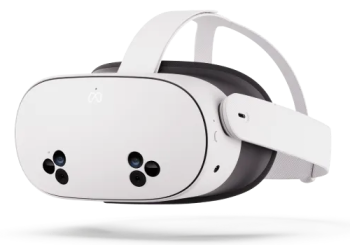
| |
| Basic Info | |
| VR/AR | Virtual Reality |
| Type | Head-mounted display |
| Subtype | Standalone VR |
| Platform | Meta Quest |
| Creator | Meta |
| Developer | Meta |
| Manufacturer | Meta |
| Announcement Date | September 25, 2024 |
| Release Date | October 15, 2024 |
| Price | $299 (128GB), $399 (256GB) |
| Website | https://www.meta.com/quest/quest-3s/ |
| Versions | 128GB, 256GB |
| Requires | Meta account |
| Predecessor | Meta Quest 2 |
| System | |
| Operating System | Meta Horizon OS |
| Chipset | Qualcomm Snapdragon XR2 Gen 2 |
| CPU | Octa-core Kryo (1 x 3.19 GHz, 4 x 2.8 GHz, 3 x 2.0 GHz) |
| GPU | Adreno 740 |
| Storage | |
| Storage | 128GB or 256GB |
| Memory | 8GB RAM |
| SD Card Slot | No |
| Display | |
| Display | Single LCD |
| Subpixel Layout | RGB stripe |
| Peak Brightness | 100 nits |
| Resolution | 1832 x 1920 pixels per eye |
| Pixel Density | 773 PPI |
| Refresh Rate | Up to 120Hz |
| Image | |
| Horizontal FoV | ~96 degrees |
| Vertical FoV | ~90 degrees |
| Rendered FoV | 104° horizontal, 98° vertical |
| Binocular Overlap | 90 degrees |
| Average Pixel Density | ~20 PPD |
| Peak Pixel Density | 20 PPD |
| Foveated Rendering | No |
| Optics | |
| Optics | Fresnel lenses |
| Ocularity | Binocular |
| IPD Range | 58-68mm (3 fixed positions: 58mm, 63mm, 68mm) |
| Adjustable Diopter | No |
| Passthrough | Color, 18 PPD |
| Tracking | |
| Tracking | 6DoF, inside-out tracking |
| Base Stations | None |
| Eye Tracking | No |
| Face Tracking | No |
| Hand Tracking | Yes |
| Body Tracking | Upper body tracking with leg position estimation |
| Rotational Tracking | Yes |
| Positional Tracking | Yes |
| Audio | |
| Audio | Integrated spatial audio speakers |
| Microphone | Yes |
| 3.5mm Audio Jack | No |
| Camera | 2x 4MP (18 PPD) RGB passthrough cameras, 4x tracking cameras |
| Connectivity | |
| Connectivity | Wi-Fi 6E, Bluetooth |
| Ports | USB-C |
| Wired Video | USB-C (Link cable) |
| Wireless Video | Wi-Fi streaming |
| WiFi | Wi-Fi 6E |
| Bluetooth | Yes |
| Battery Capacity | 4324 mAh |
| Battery Life | ~2.5 hours |
| Charge Time | ~1.8 hours (110 minutes) |
| Device | |
| Dimensions | 191.5 x 102 x 142.5 mm (without headstrap) |
| Weight | 514g (with headstrap) |
| Material | Plastic, foam facial interface |
| Headstrap | Flexible fabric strap |
| Color | White |
| Sensors | 2x RGB sensors, 4x VGA sensors, 2x IR Flood LEDs |
| Input | Touch Plus controllers, hand tracking |
Meta Quest 3S is a standalone virtual reality headset developed by Meta. Released on October 15, 2024[1], it was announced during Meta Connect 2024 on September 25, 2024[1]. The Quest 3S is Meta's entry-level VR headset, positioned as a more affordable alternative to the Meta Quest 3 with some scaled-back features while maintaining the same processing power[2][1].
History and Development
The Meta Quest 3S was officially announced by Meta on September 25, 2024, during the Meta Connect 2024 event, with preorders opening the same day[1]. It began shipping on October 15, 2024[1]. The headset was developed to replace the aging Meta Quest 2 as the company's affordable entry point into VR and MR, sitting below the flagship Meta Quest 3 in the product lineup[3][4]. This marked a shift for Meta, offering two distinct tiers within the same generation of Quest headsets[5]. The existence and name of the device were leaked prior to the official announcement[6].
Hardware
Design and Ergonomics
The Quest 3S features a white plastic body similar in overall shape to the Quest 2[7][3], but with redesigned sensor arrays on the front panel, featuring two triangular clusters instead of the Quest 3's vertical pill shapes[7]. Although physically similar in weight to the Quest 3 at 514 grams (including the default strap)[1][7], its use of bulkier Fresnel lenses means the center of gravity is further from the face, which some reviewers found slightly less comfortable or secure compared to the Quest 3[8][9].
It ships with a basic fabric Y-style headstrap, similar to the one included with the Quest 2 and Quest 3[2], which many reviewers found lacked adequate support or counterweight for the front-heavy design, often recommending an upgrade to an Elite Strap style accessory[2][3][10]. Notably, the Quest 3S strap attachment points are compatible with most existing Quest 3 headstraps[1][2][11]. A new physical "Action Button" is located on the underside of the headset, allowing users to quickly toggle between immersive VR and the passthrough view[1][3], replacing the double-tap gesture used on Quest 3[12] (though the double-tap gesture may still function). Unlike the Quest 2 and Quest 3, the Quest 3S lacks an internal proximity sensor, meaning the display doesn't automatically turn on or off when the headset is put on or removed; users must press the power button[2].
Display and Optics
The most significant cost-saving measure and point of differentiation from the Quest 3 lies in the Quest 3S's display and optical system, which is largely repurposed from the Meta Quest 2[7][8]. It uses a single fast-switch LCD panel providing a resolution of 1832 x 1920 pixels per eye, identical to the Quest 2[7][6]. This results in a lower pixel density (approximately 20 Pixels Per Degree or PPD)[1] compared to the Quest 3's 25 PPD (2064 x 2208 per eye)[7]. While the resolution difference wasn't always drastically noticeable in games due to rendering limitations, reviewers consistently noted that the Quest 3 offered a significantly sharper and clearer image, especially for text or fine details[7][8][10].
The Quest 3S employs Fresnel lenses, also inherited from the Quest 2[1][7]. These lenses are known for having a smaller "sweet spot" (the central area of maximum clarity) compared to the pancake lenses used in the Quest 3[2][8]. Image sharpness noticeably decreases towards the edges of the field of view[2][10], and Fresnel lenses are more prone to glare and god rays (internal reflections) in high-contrast scenes[2][10]. The field of view (FoV) is also narrower than the Quest 3, measured at approximately 96-97° horizontal and 90-93° vertical[7][6], compared to the Quest 3's 110° horizontal and 96° vertical[7].
Interpupillary distance (IPD) adjustment is limited to three fixed hardware positions: 58mm, 63mm, and 68mm, similar to the Quest 2[1][7]. Users manually shift the lenses between these preset grooves[8]. This contrasts with the Quest 3's continuous IPD adjustment wheel (53-75mm range)[7], potentially making it harder for some Quest 3S users to achieve optimal visual clarity and comfort if their IPD falls between the presets[8][10]. The headset includes a glasses spacer[1], and is compatible with Quest 2 prescription lens inserts[1].
Processor and Performance
The Quest 3S is powered by the Qualcomm Snapdragon XR2 Gen 2 system-on-chip, paired with 8GB of RAM[1][7]. This is the same processor and memory configuration found in the more expensive Quest 3, representing a significant performance upgrade over the Quest 2's Snapdragon XR2 Gen 1 processor (Meta claims roughly double the GPU performance)[3][13]. This allows the Quest 3S to run all existing Quest Store games and apps, including titles designed with enhanced graphics for the Quest 3 platform, such as Batman: Arkham Shadow (which was bundled free with the headset for a promotional period)[12][8]. Reviewers noted that the headset felt responsive and smooth in operation, with faster load times compared to the Quest 2[3][12].
Tracking and Controllers
The Quest 3S utilizes inside-out tracking with 6 degrees of freedom (DoF) via four integrated monochrome tracking cameras located on the front and sides of the headset[6]. Meta's inside-out tracking is generally considered robust and class-leading for standalone headsets[2]. The headset includes two Infrared (IR) flood illuminators, which improve hand tracking and controller tracking performance in low-light conditions, allowing tracking to function even in complete darkness in some scenarios – an area where it potentially outperforms the Quest 3[14][2]. The Quest 3S lacks the dedicated depth sensor found on the Quest 3, which is used by the latter to improve the speed and accuracy of automatic room scanning (scene meshing) for mixed reality setup[1].
The headset comes bundled with the same Meta Quest Touch Plus controllers used by the Quest 3[1][2]. These controllers feature a more compact design without the tracking rings found on the Quest 2's controllers[2], incorporate haptics (branded as TruTouch Haptics)[1], and use capacitive sensors on the buttons, thumbsticks, and triggers for basic finger presence detection[2]. They are powered by standard AA batteries[2][3]. While generally praised for their ergonomics and tracking accuracy[3], some tracking issues can occur if the controllers are held outside the headset cameras' view for extended periods (for example behind the back)[2]. Hand tracking is supported and benefits from the IR illuminators in low light[14], though its accuracy and usability within the Horizon OS interface were still critiqued by some reviewers as occasionally frustrating[2][10].
Audio
Audio is delivered via integrated spatial audio speakers built into the headstrap arms, similar to the Quest 3[2][3]. Reviewers generally found the audio quality to be good enough that external headphones aren't strictly necessary for most users[2][3]. However, the Quest 3S notably omits the 3.5mm headphone jack found on the Quest 2 and Quest 3[1][3]. Users wanting to use private audio must rely on USB-C headphones or Bluetooth wireless headphones[1][3].
Passthrough and Mixed Reality
A key upgrade over the Quest 2 is the inclusion of full-color stereo passthrough cameras (dual RGB sensors), enabling mixed reality experiences where virtual elements are overlaid onto the user's real-world surroundings[1][12]. Meta states the passthrough resolution is 4.5 times higher than the Quest 2's[13]. While a significant improvement over the Quest 2's low-resolution black-and-white passthrough[1], reviewers noted that the Quest 3S's passthrough quality, while usable and beneficial, appeared grainier, noisier, and less sharp compared to the Quest 3's passthrough view, likely exacerbated by the lower-resolution display and Fresnel optics[2][5]. It allows users to see their environment for setup, finding controllers, or brief interactions, but reading fine text on a phone or computer screen through passthrough remains difficult[2][5]. The headset supports automatic room scanning and boundary setup[12][9].
Battery
The Quest 3S contains a 4324 mAh battery[7][6]. Meta rates the average battery life at approximately 2.5 hours of general use, slightly longer than the Quest 3's 2.2-hour rating[1][7]. Real-world testing by reviewers typically found battery life to be around 2 hours or slightly less, especially during intensive gaming or mixed reality use[11][3][12]. The headset charges via USB-C, with a full charge taking approximately 1.8 hours (110 minutes)[3]. Due to the lack of pogo pins found on the Quest 3, the Quest 3S is not compatible with the original Quest 3 Charging Dock, though Meta released a separate "Compact Charging Dock" for the 3S[1][2].
Software
Operating System
The Quest 3S runs on Horizon OS, Meta's proprietary operating system based on Android[3][6]. It provides the interface for launching games and apps, managing settings, and accessing system features[5]. Horizon OS supports features like multi-window multitasking, allowing users to run multiple 2D apps (like browsers or media players) simultaneously in floating windows[2][3]. It also includes features for setting up play boundaries (Guardian) and managing user accounts[3]. While acknowledged as the most feature-rich OS for standalone VR headsets, Horizon OS has faced criticism for perceived clunkiness, occasional bugs, and usability issues[2][10]. System software updates are released regularly by Meta, adding features and refinements[8]. Security updates are planned until at least October 2029[3].
Content Library
The Quest 3S has access to the full Meta Quest Store, which contains hundreds of VR games, mixed reality applications, fitness programs, social experiences, entertainment apps, and productivity tools[12][11]. Because it shares the same processor as the Quest 3, it can run all titles available on the platform, including graphically demanding games and newer releases optimized for or exclusive to the Quest 3 generation hardware, such as Batman: Arkham Shadow, Asgard's Wrath 2, and Assassin's Creed Nexus VR[2][3][11]. Popular longstanding titles like Beat Saber, Superhot VR, and Resident Evil 4 VR are also available[3][12].
The headset also supports PC VR gaming when connected to a compatible gaming PC[3][9]. This can be done via a wired connection using a USB-C Link Cable or wirelessly over Wi-Fi using Air Link or third-party apps like Virtual Desktop[3][9]. This grants access to PC VR platforms like SteamVR and their respective libraries, including titles like Half-Life: Alyx[2][11].
Specifications
| Feature | Meta Quest 3S | Meta Quest 3 |
|---|---|---|
| Processor | Qualcomm Snapdragon XR2 Gen 2 | Qualcomm Snapdragon XR2 Gen 2 |
| RAM | 8GB | 8GB |
| Storage | 128GB / 256GB | 512GB |
| Display Type | Single Fast switch LCD | Dual LCD |
| Resolution (per eye) | 1832 x 1920 | 2064 x 2208 |
| Refresh Rate | Up to 120 Hz | Up to 120 Hz |
| Lens Type | Fresnel | Pancake |
| Field of View | ~96° × 90° | ~110° × 96° |
| IPD Adjustment | 3 fixed positions (58, 63, 68mm) | Continuous slider (53-75mm) |
| Passthrough | Full-color stereo (18 PPD) | Full-color stereo (18 PPD) |
| Depth Sensor | No (Uses IR Illuminators) | Yes |
| Weight (with strap) | 514g | 515g |
| Audio Jack (3.5mm) | No | Yes |
| Battery Capacity | 4324 mAh | 5060 mAh |
| Rated Battery Life | ~2.5 hours | ~2.2 hours |
| Controllers | Touch Plus (Ringless) | Touch Plus (Ringless) |
| Price (USD) | $299 (128GB) / $399 (256GB) | $499 (512GB) |
Reception
The Meta Quest 3S received generally positive reviews, primarily praised for its strong value proposition and performance capabilities at its $299 starting price[2][3][12]. It was widely regarded as the best entry-level VR headset available and a worthy successor to the Quest 2's market position, making modern standalone VR and mixed reality more accessible[3][12][4]. The inclusion of the powerful Snapdragon XR2 Gen 2 chip, identical to the Quest 3's, was highlighted as a major strength, ensuring compatibility with the latest Quest games and smooth performance[3][12][9]. The addition of full-color passthrough was seen as a significant upgrade over the Quest 2, enhancing usability and enabling mixed reality experiences, even if the quality wasn't as high as the Quest 3's[7][3][12]. The improved low-light hand tracking due to IR illuminators was also noted as a positive[2][14].
However, the primary criticisms centered on the compromises made to achieve the lower price, particularly the reuse of the Quest 2's display and Fresnel lens system[2][7][8]. Reviewers consistently pointed out the lower resolution, narrower field of view, smaller sweet spot, and increased edge blurriness compared to the Quest 3's pancake lenses, which impacted visual clarity, especially for reading text or watching media[2][8][10]. The limited 3-step IPD adjustment was also criticized as potentially problematic for users whose IPD didn't align well with the presets[8][10]. Other drawbacks mentioned included the basic comfort of the default headstrap (requiring an accessory purchase for many users)[3][10], the omission of the 3.5mm headphone jack[1][9], the relatively short battery life[5][12], and the ongoing usability critiques of Horizon OS[2][10].
Overall, the Quest 3S was recommended as an excellent choice for VR newcomers or budget-conscious buyers wanting access to the Quest ecosystem[12][5][4]. For users prioritizing the best visual quality, wider field of view, and comfort features, or those upgrading from a Quest 2 seeking a more significant leap, the Meta Quest 3 was frequently recommended as worth the additional cost[7][8][9]. The 256GB Quest 3S model at $399 was sometimes seen as poor value compared to the $499 Quest 3 (which offered 512GB storage alongside better optics)[9][10].
Images
References
<references> [1] [2] [3] [6] [7] [9] [13]
- ↑ 1.00 1.01 1.02 1.03 1.04 1.05 1.06 1.07 1.08 1.09 1.10 1.11 1.12 1.13 1.14 1.15 1.16 1.17 1.18 1.19 1.20 1.21 1.22 1.23 1.24 1.25 Heaney, David (September 25, 2024). "Quest 3S Is Official: XR2 Gen 2 Chipset, Mixed Reality And Fresnel Lenses For $300". https://www.uploadvr.com/meta-quest-3s-officially-announced/. Retrieved May 4, 2025.
- ↑ 2.00 2.01 2.02 2.03 2.04 2.05 2.06 2.07 2.08 2.09 2.10 2.11 2.12 2.13 2.14 2.15 2.16 2.17 2.18 2.19 2.20 2.21 2.22 2.23 2.24 2.25 2.26 2.27 2.28 2.29 2.30 Lang, Ben (October 17, 2024). "Quest 3S Review – Value That Can't Be Beat, With the Same Rough Edges as Its Siblings". https://www.roadtovr.com/meta-quest-3s-review-value-that-cant-be-beat/. Retrieved May 4, 2025.
- ↑ 3.00 3.01 3.02 3.03 3.04 3.05 3.06 3.07 3.08 3.09 3.10 3.11 3.12 3.13 3.14 3.15 3.16 3.17 3.18 3.19 3.20 3.21 3.22 3.23 3.24 3.25 3.26 3.27 Gibbs, Samuel (November 25, 2024). "Meta Quest 3S review: the best bang for your buck in VR". https://www.theguardian.com/technology/2024/nov/25/meta-quest-3s-review-the-best-bang-for-your-buck-in-vr. Retrieved May 4, 2025.
- ↑ 4.0 4.1 4.2 Peters, Jay (January 14, 2025). "Meta Quest 3S review: probably the one we've been waiting for". https://www.theverge.com/24340948/meta-quest-3s-vr-headset-review. Retrieved May 4, 2025.
- ↑ 5.0 5.1 5.2 5.3 5.4 5.5 Unknown (November 2, 2024). "Review: Meta Quest 3S". https://www.wired.com/review/meta-quest-3s/. Retrieved May 4, 2025.
- ↑ 6.0 6.1 6.2 6.3 6.4 6.5 6.6 6.7 "Meta Quest 3S Specs". https://vr-compare.com/headset/metaquest3s. Retrieved May 4, 2025.
- ↑ 7.00 7.01 7.02 7.03 7.04 7.05 7.06 7.07 7.08 7.09 7.10 7.11 7.12 7.13 7.14 7.15 7.16 7.17 7.18 7.19 Greenwald, Will (November 21, 2024). "Meta Quest 3 vs. Meta Quest 3S: What's the Difference?". https://www.pcmag.com/comparisons/meta-quest-3-vs-meta-quest-3s-whats-the-difference. Retrieved May 4, 2025.
- ↑ 8.00 8.01 8.02 8.03 8.04 8.05 8.06 8.07 8.08 8.09 8.10 8.11 Hector, Hamish (October 14, 2024). "Meta Quest 3S review: the world's best affordable VR headset". https://www.techradar.com/computing/virtual-reality-augmented-reality/meta-quest-3s-review-an-affordable-mixed-reality-headset-that-everyone-might-want. Retrieved May 4, 2025.
- ↑ 9.0 9.1 9.2 9.3 9.4 9.5 9.6 9.7 9.8 Ridley, Jacob (November 14, 2024). "Meta Quest 3S review". https://www.pcgamer.com/hardware/vr-hardware/meta-quest-3s-review/. Retrieved May 4, 2025.
- ↑ 10.00 10.01 10.02 10.03 10.04 10.05 10.06 10.07 10.08 10.09 10.10 10.11 Erl, Josef (December 15, 2024). "Meta Quest 3S Review: An entry-level VR headset that doesn't always make things easy for beginners". https://mixed-news.com/en/meta-quest-3s-review/. Retrieved May 4, 2025.
- ↑ 11.0 11.1 11.2 11.3 11.4 Moss, Gabriel (October 24, 2024). "Meta Quest 3S Review". https://www.ign.com/articles/meta-quest-3s-review. Retrieved May 4, 2025.
- ↑ 12.00 12.01 12.02 12.03 12.04 12.05 12.06 12.07 12.08 12.09 12.10 12.11 12.12 12.13 Polanco, Tony (October 14, 2024). "Meta Quest 3S review: The best VR headset for the money". https://www.tomsguide.com/computing/vr-ar/meta-quest-3s-review. Retrieved May 4, 2025.
- ↑ 13.0 13.1 13.2 "Meta Quest 3S". https://www.meta.com/quest/quest-3s/. Retrieved May 4, 2025.
- ↑ 14.0 14.1 14.2 Heaney, David (October 10, 2024). "Quest 3S Has Better Low-Light Head & Hand Tracking Than Quest 3". https://www.uploadvr.com/quest3s-hand-tracking-better-than-quest-3/. Retrieved May 4, 2025.


